
|
|
|
|
|
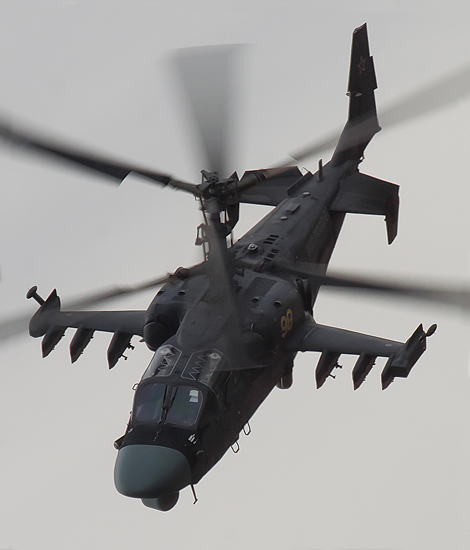
|
Attack Helicopters in Action; Zhukovskiy, August 10 - 12, 2012
100 Years VVS, part 7; Text and Photograph's by Alex van Noye
The attack helicopters have an important role within the VVS. In the past, the importan- ce of strong attack helicopters
was demonstrated during the Afghanistan War. The VVS has 3 types of attack helicopters in its orbat, namely; the Kamov
Ka-52 Alligator or Hokum B, the Mil Mi-24 Hind and the Mil Mi-28 Havoc.
The Russian attack helicopters are frequently used in the past during various armed conflicts. Particularly in Afghanistan,
the helicopters played an important role. The war between the Soviet Union and Afghanistan lasted from 1979 to 1989. Mainly
the Mi-8 Hip and Mi-24 Hind played an important role during this war. These two helicopters were at that time the backbone
of the Russian helicopter fleet. There were lots of helicopters lost during the war, because the Afghans used American
Stinger air defensive systems. The Stinger is a rocket which is launched from the shoulder of a soldier; it is a heat
seeking missile. Especially the Russian helicopters were victim of this weapon, because they usually fly at low level.
In total, the Russian Air Force lost 45 Hips and 74 Hinds because of this weapon. Despite these losses, the Hind proved
to be a very effective weapon on the battlefield. The Afghan government decided in 1979 to use the Mi-24 Hind to fight
against the Mujahideen guerrillas. The Soviet army was soon involved in this war in Afghanistan. The Mi-24 was soon
nicknamed Shaitan-Arba (Satan's Chariot) by the Guerrillas, because of its strength and its weapons arsenal. The Soviets
were withdrawn from the area in 1989 during the fall of the Soviet Union. The rebels took over power in Afghanistan,
because the government army was overwhelmed without the Soviet help.
The Kamov Ka-50 Black Shark (Ka-50 Чёрная акула) is a single seat attack helicopter of the Russian VVS. The NATO
designation for this helicopter is Hokum A. The helicopter is recognizable by its dual counter-rotating rotors. The
Hokum A is a helicopter which doesn’t need a tail rotor because of this concept. The Ka-50 was developed at the
beginning of the 80s as a possible successor of the Mi-24 Hind. The helicopter was taken in service in 1995, but
only a few helicopters were built. Only 8 Ka-50 helicopters were built. The Ka-52 was developed at the end of the
90s. This helicopter was an improved version of the Ka-50. The Ka-52 Alligator (Ka-52 Аллига-
|
|
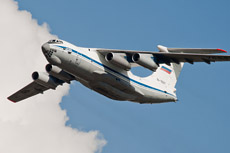
|
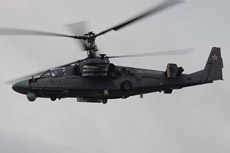
|
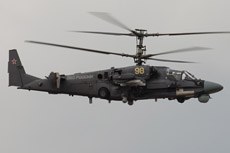
|
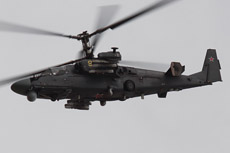
|
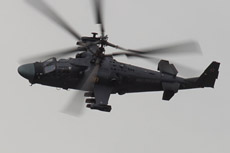
|
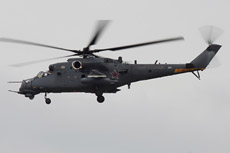
|
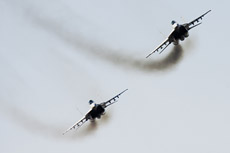
|
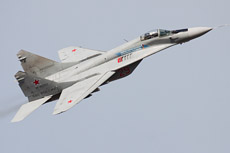
|
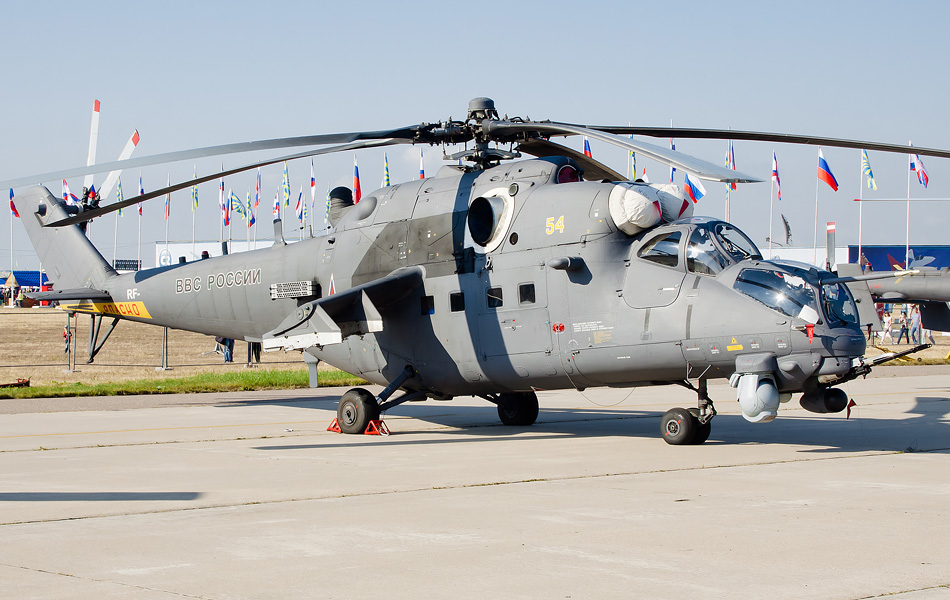
|
тор) was by NATO designated as the Hokum B. The concept of the helicopter was the same as the Hokum A; the only difference
is the number of pilots, because the Hokum B is flown by two crew members. The collaboration with Israel Aerospace Industries
during the design period made the Hokum B a competitor in the race for a new Turkish attack helicopter. The Ka-52 has in
addition to the dual rotor construction also 4 suspension points for external weapons under the wings and 2 on the wingtips.
The armament consists of maximum 12 laser guided Vikhr anti-tank missiles with a range of 8 km. The helicopter can also be
equipped with rocket pods containing S-8 or S-13 unguided rockets. A 30mm cannon is mounted on the right side of the
helicopter. The gun cannot move making it a more effective weapon than a turret which can rotate. The VVS has currently
20 Ka-52 helicopters in service. The complete order contains a total of 140 helicopters for the VVS. These helicopters
will be delivered before 2020.
The Mil Mi-24 (Миль Ми-24) is a heavy attack helicopter of the Russian Army. The NATO code name of the Mi-24 is Hind.
The design of the Mil Mi-24 is based on the design of the Mil Mi-8 Hip; this helicopter is a medium weight transport
helicopter. The Mi-24 made its first flight in 1966. The Mi-24 Hind entered service in the Soviet Air Force in 1972.
The Hind has 2 wings which are suitable to carry external weapons. The helicopter is able to carry anti-tank missiles,
rockets and light external gunpods with the help of these wings. A total amount of 1,500 kg of external load can be
carried under the wings. A GSh-23mm or a GSh30mm cannon can be mounted under the nose section of the Hind. However,
most variants of the Hind carry the 4 loop Yak-B 12.7mm Gatling Gun under the nose section of the helicopter. The
Hind is also able to transport 8 passengers next to this extensive arsenal. The rotor blades are made of titanium
and the fuselage of the helicopter is heavily armored. The Russian VVS has currently an estimated amount of approximately
624 Mi-24s in operational service. The helicopters are mostly of the type Mi-24V and Mi-24PN. Also 49 Mi-35M helicopters
will be delivered to the VVS before the end of 2014. The Mi-35 is the export version of the Mi-24. This helicopter is also
an updated version of the Mi-24. The VVS decided to use the Mi-35 as well because of its performance. The Mi-28 Havoc
will replace a part of the outdated Mi-24 fleet; the rest of the Mi-24 fleet will be updated.
The Mil Mi-28 (Миль Ми-28) is a helicopter which has fully been developed for the offensive role. The NATO code name for
the Mi-28 is Havoc. The Mi-28 is the optimized version of the Mi-24 Hind in the offensive role. The actual development of
the Mi-28 was started in 1980 and the first prototype was ready in 1982. The Soviet Government decided to develop the Ka-50
Hokum A above the design of the Mi-28 Havoc. The development of the Mi-28 disappeared to the background. The first prototype
of the Mi-28A made its first flight in 1987. The Mil Mi-28 program was cancelled in 1993. It took 10 years until 2003 before
the program was restarted which led to the Mi-28N design. The Mi-28N variant uses techniques which are similar to the AH-64D
Longbow. Compared to the Mi-28A, the Mi-28N design has the latest modern electronics on board such as the helmet mounted
display. The first Mi-28N helicopters entered service recently at the VVS. The Mi-28 is the Russian counterpart of the
American Boeing AH-64D Apache. The standard armament of the Mi-28 consists mainly of a set of 8 Ataka missile holders
and 2 B-13L rocket pods. The rocket pods may contain 5x the S-13 rocket or 20x the S-8 rocket. A standard 30mm chain gun
of the type Shipunov 2A42 Auto Cannon is mounted under the nose of the Mi-28N. The Russian VVS has currently 52 Mi-28
helicopters in service. These helicopters are divided over four regiments in Russia. The order comprises a total of 97
helicopters; all helicopters have to be delivered at the end of 2014.
|
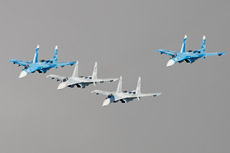
|
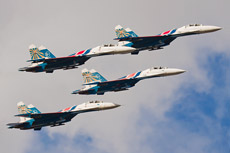
|
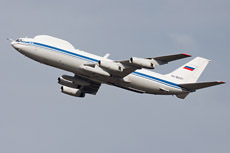
|
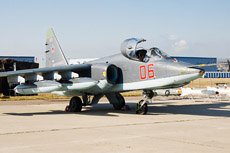
|
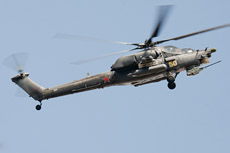
|
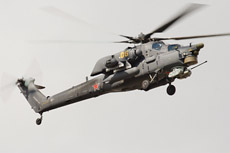
|
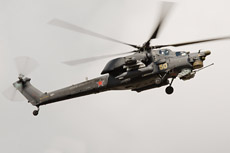
|
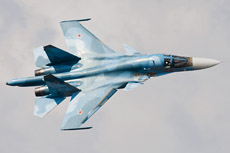
|
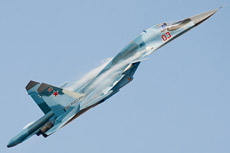
|
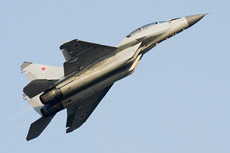
|

|
|
|

|







